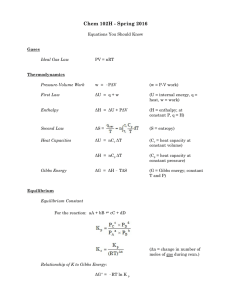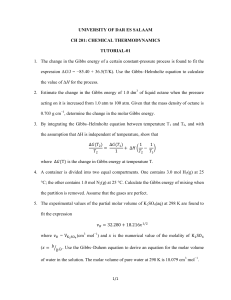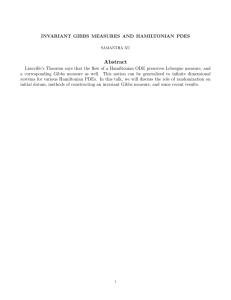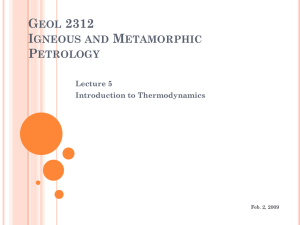Gibbs Free Energy
advertisement
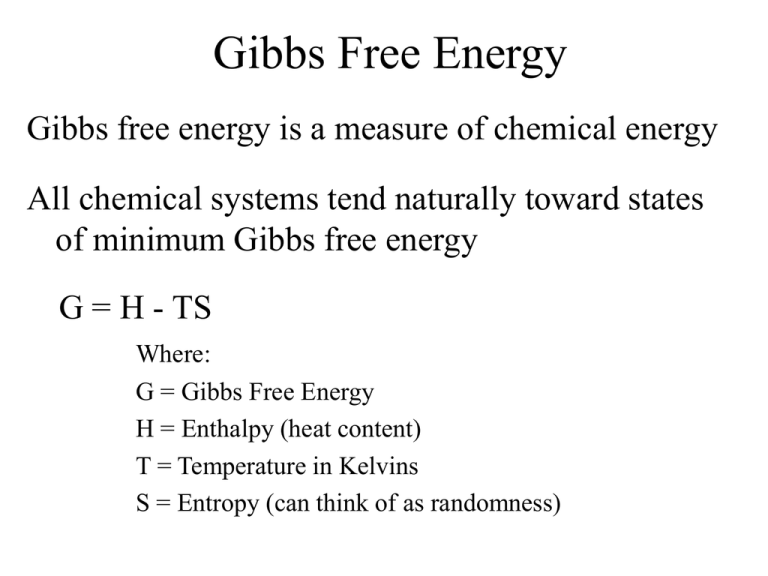
Gibbs Free Energy Gibbs free energy is a measure of chemical energy All chemical systems tend naturally toward states of minimum Gibbs free energy G = H - TS Where: G = Gibbs Free Energy H = Enthalpy (heat content) T = Temperature in Kelvins S = Entropy (can think of as randomness) Gibbs Free Energy • Products and reactants are in equilibrium when their Gibbs free energies are equal • A chemical reaction will proceed in the direction of lower Gibbs free energy (i.e., DGr < 0) …so the reaction won’t proceed if the reaction produces an increase in Gibbs free energy Gibbs Free Energy DG°r = SnG°f (products) - SnG°f (reactants) DG°r > 0, backwards reaction with deficient energy DG°r < 0, forwards reaction with excess energy DG°r = 0, reaction is in equilibrium DG°r is a measure of the driving force DG free energy of formation o f Thermodynamics For a phase we can determine V, T, P, etc., but not G or H We can only determine changes in G or H as we change some other parameters of the system Example: measure DH for a reaction by calorimetry - the heat given off or absorbed as a reaction proceeds Arbitrary reference state and assign an equally arbitrary value of H to it: Choose 298.15 K/25°C and 0.1 MPa/1 atm/1 bar (lab conditions) ...and assign H = 0 for pure elements (in their natural state - gas, liquid, solid) at that reference Thermodynamics In our calorimeter we can then determine DH for the reaction: Si (metal) + O2 (gas) = SiO2 DH = -910,648 J/mol = molar enthalpy of formation of quartz (at 25°C, 1 atm) It serves quite well for a standard value of H for the phase Entropy has a more universal reference state: entropy of every substance = 0 at 0K, so we use that (and adjust for temperature) Then we can use G = H - TS to determine G for quartz = -856,288 J/mol Thermodynamics DG RT ln K o R K=equilibrium constant at standard T T in kelvin 298.18K R=gas constant=1.987 cal/molo DG 1.364 log K o R K 10 DGRo 1.364 Example: What is the DGoR of calcite dissociation? CaCO3 Ca2+ + CO32- Use data in appendix B for DGof DGoR = [(-132.3)+(-126.17)] - [(-269.9)] = +11.43 kcal (+) means that the reaction goes from right to left so K must be small What is the value of K? K 10 DGRo 1.364 K = 10(-11.43/1.364) = 10-8.3798 = 4.171 x 10-9 What if T 25oC? Use the Van’t Hoff Equation DG RT ln K and DG°r = DH°r-TDS°r o R We can derive: lnKT - lnKT° = (-DH°r/R)(1/T-1/T°) o D H 1 1 o R log KT log KT 2.3025R T 298.15 DH Ro Enthalpy of reaction R=1.987 cal/mol° T in Kelvin Example: What is KT of calcite dissociation at T=38°C? o D H 1 1 o R log KT log KT 2.3025R T 298.15 DH Ro = [(-129.74)+(-161.8)] - [(-288.46)] = -3.08 3.08 1 1 log KT log( 4.71x10 ) 9.0532 2.3025(1.987) 311 298.15 9 KT 8.85 x10 10 (KT° = 4.171 x 10-9) When T increases, K decreases Thermodynamics Summary thus far: – G is a measure of relative chemical stability for a phase – We can determine G for any phase by measuring H and S for the reaction creating the phase from the elements – We can then determine G at any T and P mathematically • Most accurate if know how V and S vary with P and T – dV/dP is the coefficient of isothermal compressibility – dS/dT is the heat capacity (Cp) If we know G for various phases, we can determine which is most stable • Why is melt more stable than solids at high T? • Is diamond or graphite stable at 150 km depth? • What will be the effect of increased P on melting?
